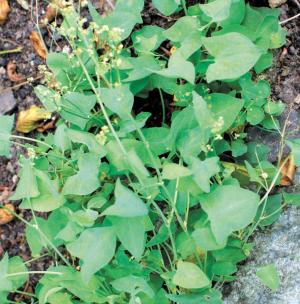Have some French sorrel potted up
France gave the world two great things - the French Revolution and French cuisine. In a way, the French Revolution helped French cuisine become, well, fit for a king. When their bosses, the nobility, literally lost their jobs to the chopping block, an army of chefs and support staff were also out of work. Because the traditional craft guilds were done away with during the Revolution, everyone was free to produce and sell any culinary item they wanted. The result is a culinary world so vast that it has its own guidebook, the Guide Michelin.
The classic French meal is three courses, starting with the entrance or entrée, which is often soup, then the main course. Dinner ends with the cheese course or dessert. Oh, and sometimes there's a salad following the main course. Oooh la la (as I'm certain nobody actually says in France), French salad! Like life itself, its sweet greens are tempered by more bitter greens, and the best of the bitter greens are the leaves of French sorrel (Rumex scutatus). Beware of fake Cartier watches and imitation French sorrel. French sorrel is finer flavored and less acidic than common sorrel (Rumex acetosa), so check the botanical name before buying.
French sorrel has a distinctive lemon mixed with apple flavor that is somewhat tart due to oxalic acid, yet still pleasant mixed in with milder greens. Even though oxalic acid is harmless when eaten in small amounts, it should should be avoided by people with a history of kidney stones. While traditionally used in mixed green salads, you can serve French sorrel leaves steamed as a side dish, or cooked into creamy French sorrel soup, baked French sorrel and goat cheese quiche, sorrel pesto, or Charlotte potato salad made with wilted French sorrel, yogurt, chives and grated horseradish.
And best of all, if you have some French sorrel potted up, you can bring the plant indoors to harvest all winter. It is quite hardy in the average house temperature.
Planted in the garden, this hardy perennial does best in full sun where it quickly grows to a clump up to three feet in diameter. French sorrel only grows eight to 12 inches tall with long, four-inch-wide leaves. These cold-hardy plants return year after year in USDA zones 4-9. They are resistant to brief droughts.
You can start French sorrel from seed. Sow the seeds shallowly, no more than one-quarter-inch deep. Keep the soil well-moistened, but not soggy. The seeds germinate in seven to 14 days at 55-70° F. Transplant outside after all danger of frost has passed. It grows best in full sun, with moist, fertile soil. As with any salad green, you can pick the leaves anytime, but expect a full crop after just 60 days from planting. Leave half of the leaves each harvest, and your plants will produce all year long.
If you want to save your own French sorrel seeds, let the plants flower and set seedheads. Leave the seedheads to dry on the plant. Once they are completely dry, carefully thresh them over a bowl. Remove the chaff by pouring the seed in front of a fan. Store seeds in a tightly sealed jar in a cool, dry place out of direct sunlight.
Plant French sorrel (Rumex scutatus) even in the fall, and soon enough you will be stirring up fresh French sorrel béchamel sauce, waiting breathlessly for Guide Michelin to knock on your door. Or not.






















































